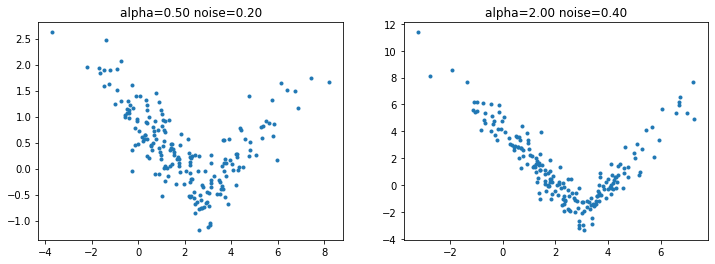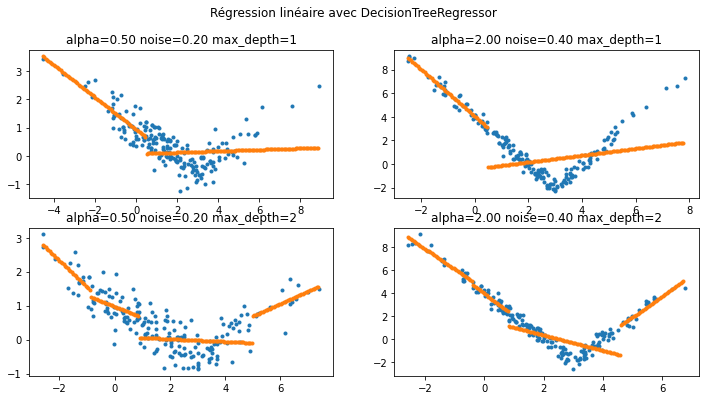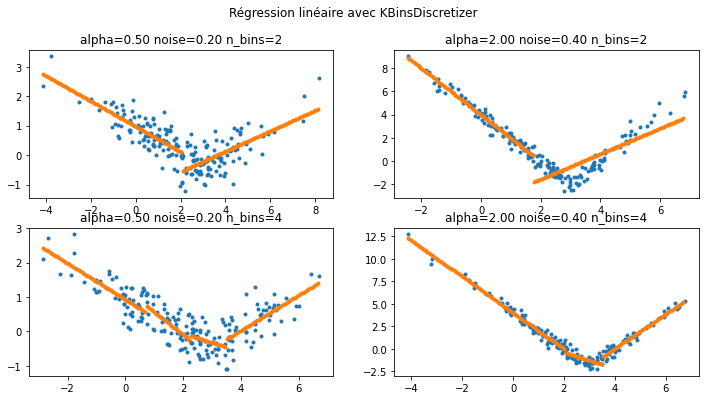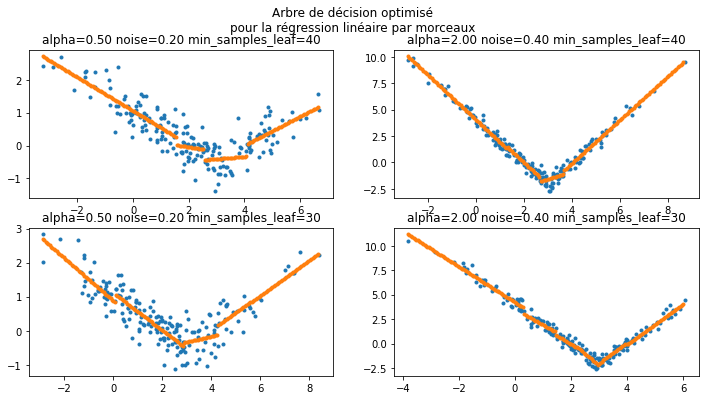Régression linéaire par morceaux#
Links: notebook, html, PDF, python, slides, GitHub
La régression linéaire par morceaux a l’avantage de produire un modèle localement interprétable. Mais ce n’est pas évident d’estimer un tel modèle quand on ne connaît pas les morceaux par avance.
from jyquickhelper import add_notebook_menu
add_notebook_menu()
%matplotlib inline
Des données artificielles#
from numpy.random import normal
import numpy
import matplotlib.pyplot as plt
def nuage(n, alpha, noise=0.2):
eps = normal(0, 2, (n, 2))
X = eps[:, 0] + 2
X1 = eps[:, 0].copy()
X2 = eps[:, 0].copy()
th = 1.
X1[X1 <= th] = 0
X2[X2 > th] = 0
sel = numpy.zeros((n,))
sel[X1 > th] = 1
Y = X1 * alpha - X2 * alpha + eps[:, 1] * noise - sel * alpha * th * 2
return X, Y
fig, ax = plt.subplots(1, 2, figsize=(12, 4))
alpha, noise = 0.5, 0.2
X, Y = nuage(200, alpha)
ax[0].plot(X, Y, '.')
ax[0].set_title("alpha=%1.2f noise=%1.2f" % (alpha, noise));
alpha, noise = 2., 0.4
X, Y = nuage(200, alpha, noise=0.4)
ax[1].plot(X, Y, '.')
ax[1].set_title("alpha=%1.2f noise=%1.2f" % (alpha, noise));

Quelques exemples avec un arbre de décision#
La segmentation est réalisée d’abord avec un arbre de décision dont on fixe la profondeur. Chaque segment est choisi de telle sorte à minimiser l’approximation de la fonction par une constante sur chaque segment.
from mlinsights.mlmodel import PiecewiseRegressor
from sklearn.tree import DecisionTreeRegressor
def nuage_piecewise(n, alpha, noise=0.2, max_depth=1):
X, Y = nuage(n, alpha, noise=noise)
clr = PiecewiseRegressor(binner=DecisionTreeRegressor(max_depth=max_depth))
Xm = X.reshape((len(X), 1))
clr.fit(Xm, Y)
mi, ma = X.min(), X.max()
Xm = numpy.arange(0, 200) * (ma - mi) / 200 + mi
Xm = Xm.reshape((len(Xm), 1))
return X, Y, Xm, clr.predict(Xm)
def plot(i, j, alpha, noise, max_depth, ax):
X, Y, XX, Z = nuage_piecewise(200, alpha, max_depth=max_depth)
ax[i, j].plot(X, Y, '.')
ax[i, j].plot(XX, Z, '.')
ax[i, j].set_title("alpha=%1.2f noise=%1.2f max_depth=%d" % (
alpha, noise, max_depth))
fig, ax = plt.subplots(2, 2, figsize=(12, 6))
alpha, noise, max_depth = 0.5, 0.2, 1
plot(0, 0, alpha, noise, max_depth, ax)
alpha, noise, max_depth = 2., 0.4, 1
plot(0, 1, alpha, noise, max_depth, ax)
alpha, noise, max_depth = 0.5, 0.2, 2
plot(1, 0, alpha, noise, max_depth, ax)
alpha, noise, max_depth = 2., 0.4, 2
plot(1, 1, alpha, noise, max_depth, ax)
plt.suptitle("Régression linéaire avec DecisionTreeRegressor");

Quelques exemples avec un KBinsDiscretizer#
from mlinsights.mlmodel import PiecewiseRegressor
from sklearn.preprocessing import KBinsDiscretizer
def nuage_piecewise2(n, alpha, noise=0.2, n_bins=2):
X, Y = nuage(n, alpha, noise=noise)
clr = PiecewiseRegressor(binner=KBinsDiscretizer(n_bins=n_bins))
Xm = X.reshape((len(X), 1))
clr.fit(Xm, Y)
mi, ma = X.min(), X.max()
Xm = numpy.arange(0, 200) * (ma - mi) / 200 + mi
Xm = Xm.reshape((len(Xm), 1))
return X, Y, Xm, clr.predict(Xm)
def plot2(i, j, alpha, noise, n_bins, ax):
X, Y, XX, Z = nuage_piecewise2(200, alpha, n_bins=n_bins)
ax[i, j].plot(X, Y, '.')
ax[i, j].plot(XX, Z, '.')
ax[i, j].set_title("alpha=%1.2f noise=%1.2f n_bins=%d" % (
alpha, noise, n_bins))
fig, ax = plt.subplots(2, 2, figsize=(12, 6))
alpha, noise, n_bins = 0.5, 0.2, 2
plot2(0, 0, alpha, noise, n_bins, ax)
alpha, noise, n_bins = 2., 0.4, 2
plot2(0, 1, alpha, noise, n_bins, ax)
alpha, noise, n_bins = 0.5, 0.2, 4
plot2(1, 0, alpha, noise, n_bins, ax)
alpha, noise, n_bins = 2., 0.4, 4
plot2(1, 1, alpha, noise, n_bins, ax)
plt.suptitle("Régression linéaire avec KBinsDiscretizer");

C’est mieux mais ce n’est pas parfait. La classe KBinsDiscretizer fonctionne simplement en segmentant les données mais elle ne tient pas compte de la cible.
Arbre de décision optimisé pour la régression linéaire#
L’arbre suivant reprend l’algorithme de l’arbre de décision à ceci près
qu’il optimise un critère
MSE
en approximant le nuage de points par une fonction
linéaire
. Il faut néanmoins
augmenter le nombre de points par feuille pour éviter quelques
artefacts.
from mlinsights.mlmodel.piecewise_tree_regression import PiecewiseTreeRegressor
from sklearn.preprocessing import KBinsDiscretizer
def nuage_piecewise2(n, alpha, noise=0.2, min_samples_leaf=30):
X, Y = nuage(n, alpha, noise=noise)
clr = PiecewiseTreeRegressor(criterion='mselin',
min_samples_leaf=min_samples_leaf)
Xm = X.reshape((len(X), 1))
clr.fit(Xm, Y)
mi, ma = X.min(), X.max()
Xm = numpy.arange(0, 200) * (ma - mi) / 200 + mi
Xm = Xm.reshape((len(Xm), 1))
return X, Y, Xm, clr.predict(Xm)
def plot2(i, j, alpha, noise, min_samples_leaf, ax):
X, Y, XX, Z = nuage_piecewise2(200, alpha,
min_samples_leaf=min_samples_leaf)
ax[i, j].plot(X, Y, '.')
ax[i, j].plot(XX, Z, '.')
ax[i, j].set_title("alpha=%1.2f noise=%1.2f min_samples_leaf=%d" %(
alpha, noise, min_samples_leaf))
fig, ax = plt.subplots(2, 2, figsize=(12, 6))
alpha, noise, min_samples_leaf = 0.5, 0.2, 40
plot2(0, 0, alpha, noise, min_samples_leaf, ax)
alpha, noise, min_samples_leaf = 2., 0.4, 40
plot2(0, 1, alpha, noise, min_samples_leaf, ax)
alpha, noise, min_samples_leaf = 0.5, 0.2, 30
plot2(1, 0, alpha, noise, min_samples_leaf, ax)
alpha, noise, min_samples_leaf = 2., 0.4, 30
plot2(1, 1, alpha, noise, min_samples_leaf, ax)
plt.suptitle("Arbre de décision optimisé\npour la régression linéaire par morceaux");
C:xavierdupre__home_github_forkscikit-learnsklearntree_classes.py:335: FutureWarning: The parameter 'X_idx_sorted' is deprecated and has no effect. It will be removed in 1.1 (renaming of 0.26). You can suppress this warning by not passing any value to the 'X_idx_sorted' parameter. warnings.warn( C:xavierdupre__home_github_forkscikit-learnsklearntree_classes.py:335: FutureWarning: The parameter 'X_idx_sorted' is deprecated and has no effect. It will be removed in 1.1 (renaming of 0.26). You can suppress this warning by not passing any value to the 'X_idx_sorted' parameter. warnings.warn( C:xavierdupre__home_github_forkscikit-learnsklearntree_classes.py:335: FutureWarning: The parameter 'X_idx_sorted' is deprecated and has no effect. It will be removed in 1.1 (renaming of 0.26). You can suppress this warning by not passing any value to the 'X_idx_sorted' parameter. warnings.warn( C:xavierdupre__home_github_forkscikit-learnsklearntree_classes.py:335: FutureWarning: The parameter 'X_idx_sorted' is deprecated and has no effect. It will be removed in 1.1 (renaming of 0.26). You can suppress this warning by not passing any value to the 'X_idx_sorted' parameter. warnings.warn(

Il faudrait ajouter des contraintes de continuité.